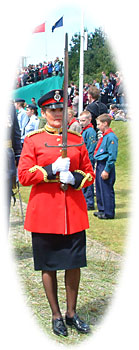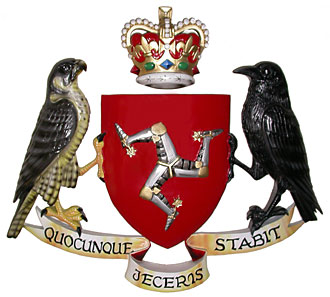|
manxscenes.com |
manxscenes.com |
manxscenes.com |
manxscenes.com |
-
- THE ISLE OF MAN
- THE COAT
OF ARMS
- THE MANX SWORD OF
STATE
- THE MANX PARLIAMENT
-
|
-
Above -
Original picture of the Manx Coat of Arms
-
as
displayed in the Royal Chapel at St. Johns - (next to Tynwald
Hill)
|
 Isle of Man Capital: Douglas
Isle of Man Capital: Douglas
 Approximate Population:
85,000
Approximate Population:
85,000
 Land Area:
572 sq. km/ 227
square miles
Land Area:
572 sq. km/ 227
square miles
 Location:
The centre of the
Irish Sea - 50 km (31 miles) from Ireland and 50 km (31 miles)
from the U.K.
Location:
The centre of the
Irish Sea - 50 km (31 miles) from Ireland and 50 km (31 miles)
from the U.K.
 Longest River: Sulby (17 km/
10.5 miles)
Longest River: Sulby (17 km/
10.5 miles)
 Highest Peak:
Snaefell Mountain
(Snow Mountain)
(621 m/
2036 feet)
Highest Peak:
Snaefell Mountain
(Snow Mountain)
(621 m/
2036 feet)
 Head of State: Her Majesty the
Queen
Head of State: Her Majesty the
Queen
 Her Majesty the Queens
Personal Representative: Lieutenant Governor Sir Richard Gozney who is the Islands 30th Crown representative for the Island
Her Majesty the Queens
Personal Representative: Lieutenant Governor Sir Richard Gozney who is the Islands 30th Crown representative for the Island
 Status: An internally
self-governing dependent territory of the Crown which is not part
of the United Kingdom
Status: An internally
self-governing dependent territory of the Crown which is not part
of the United Kingdom
 Parliament: Tynwald
Parliament: Tynwald
 Currency: Manx pounds and
pence (equivalent to GB pounds)
Currency: Manx pounds and
pence (equivalent to GB pounds)
 Languages: English and Manx
Gaelic
Languages: English and Manx
Gaelic
|
-
- The Coat Of Arms
(as seen above)
-
The
Coat of Arms of the Isle of Man were granted by Her Majesty
by Royal Warrant dated 12th July 1996. The Arms are an augmented version
of the traditional arms which comprise the Three Legs conjoined on a red
shield surmounted by a Crown and with the motto Quocunque Jeceris Stabit
underneath. In heraldic terms the Arms are described:
-
-
"For the Arms: Gules a Triskele Argent garnished and spurred Or And for
the Crest ensigning the Shield of Arms An Imperial Crown proper and for
the Supporters Dexter a Peregrine Falcon and sinister a Raven both
proper together with this Motto Quocunque Jeceris Stabit."
-
- The Peregrine Falcon
(as seen above)
-
In 1405, King Henry
IV gave the Isle of Man with all its rights to Sir John Stanley on
condition that he paid homage and gave two falcons to him and to every
future King of England on his Coronation Day. Sir John's descendants
ruled as Kings or Lords of Mann for 360 years until George III assumed
the Lordship, while the presentation of two falcons continued up to the
Coronation of George IV in 1822.
-
- The Raven
(as seen above)
-
The Raven is a bird of legend and superstition and there
are a number of places on the Island which include Raven in their names.
The Island has a strong Viking element in its history and Odin, the
Norse God, was, according to mythology, accompanied by two Ravens.
During the Millennium Year of 1979, a replica of a Viking longship was
sailed from Norway to the Isle of Man by a mixed Norwegian and Manx
crew. The longship, which is now preserved on the Island, is called
"Odin's Raven".
-
- The Motto
(as seen above)
-
The
motto "Quocunque Jeceris Stabit", which translates literally as
"whichever
way you throw me, I will stand", continues to feature on the
Coat of Arms. This motto has been associated with the Isle of Man since
circa 1300. It was, reportedly, in use before this date by the MacLeods
of Lewis as ancient Lords of the Isles of Scotland which, after 1266,
included the Isle of Man.
-
- The Three Legs of Mann
(as seen above)
-
The
three legs symbol seems to have been adopted in the Thirteenth Century
as the armorial bearings of the native kings of the Isle of Man, whose
dominion also included the Hebrides - the Western Isles of Scotland.
-
-
After 1266, when the native dynasty ended and control of the Island
passed briefly to the Crown of Scotland and then permanently to the
English Crown, the emblem was retained, and among the earliest surviving
representations are those of the Manx Sword of State, thought to have
been made in the year 1300 AD. The Three Legs also appeared on the Manx
coinage of the seventeenth-nineteenth centuries, and are still in
everyday use in the Manx Flag.
-
-
Why
the Three Legs were adopted as the royal arms of the Manx kingdom is
unknown. It was originally a symbol of the Sun, the seat of Power and
Life. In ancient times the emblem was particularly connected with the
island of Sicily (probably because of its triangular outline) but the
Sicilian "Legs" were always naked and generally displayed Medusa's head
at the central point.
-
-
A
rather similar device was popular amongst the Celts and Norsemen in NW
Europe, and in view of this it has been suggested that the Manx Three
Legs were a heraldic modification of a native badge or emblem. Support
for this theory may be seen in the appearance of the 'triskele', or
simplified "Three Legs" emblem, on coins of the tenth century Norse
King, Anlaf Cuaran, whose dominion included Dublin and the Isle of Man;
and it is probable that the later Manx Kings were a branch of the same
dynasty.

The ancient Manx
Sword of State
The Ancient Manx Sword of
State is carried by the sword bearer before the Queens personal
representative to the Isle of Man, the Lieutenant Governor,
at each meeting of Tynwald day at St. John's. The Sword of State dates
from not later than the 12th Century. It is traditionally the sword of
Olaf Godredson (Olaf II or Olaf the Black), who became King of the Sudreys
(Southern Hebrides and Man) in 1226. Together with an army of northern
Manx men he successfully routed a challenge to his rule on 14th February
in 1228 at Tynwald (considered to be Tynwald Hill, St John's).
The ceremonial sword is used
at the Tynwald Day sitting at St Johns and is carried by the Sword Bearer
preceding the Lieutenant Governor in the procession. It
also appears when Tynwald sits in the Legislative Chambers in Douglas
where a replica of the sword is displayed on non-sitting days.
The sword signifies the duty
of the Sovereign, acting through Tynwald, to protect and defend the people
from the incursions of their enemies, in peace and in war. Tynwald is not
properly constituted and no proceedings can take place without its
presence. Members show deference to its authority by standing in their
places as the sword is brought in and placed in position prior to
commencement of business.
The ancient Manx Sword of State has a
two-edged steel blade, 29 inches long, with a hardwood hilt, 9 inches
long, which tapers from the guard to the pommel. The guard is a thin steel
band, 11 inches across, surmounted where the guard intersects the blade
with shields carrying the Three Legs, which also appear on the flattened
pommel.
-
 The Manx Parliament The Manx Parliament
-
-
The Island is a Crown Dependency which, through its ancient
parliament, Tynwald, enjoys a high degree of domestic legislative
and political autonomy. The United Kingdom Government is, by
convention, responsible for the conduct of the external relations
and defence of the Island.
-
Dating back over one thousand years to Viking origins,
"Tynwald
is the oldest Parliament
in the world in continuous existence".
It comprises
two branches - the
democratically elected
House of Keys and the Legislative Council. The majority of Members
sit as independents, and the virtual absence of party politics
encourages a high degree of consensus. This has contributed to the
remarkable stability of the Manx system.
External issues such as foreign representation and defence are
administered on the Island's behalf by the UK Government.
The 24 members of the House of Keys (MHKs) are elected every five
years and represent the
following ancient Sheadings of Mann -
Ayre, Castletown, Douglas, Garff, Glenfaba,
Malew/Santon, Michael, Middle, Onchan, Peel, Ramsey and Rushen.
The 11
members of the Legislative Council (MLCs)
or upper house,
generally act as a
chamber which revises Bills initiated in the Keys. The royal
assent to Tynwald Bills is given by the Queen or, now more
commonly, by his Excellency the Lieutenant Governor on the Isle of
Man.
The political head of the Manx Government is the Chief Minister,
who is chosen by Tynwald from within its own ranks after each
general election. The Chief Minister selects his ministers who
have responsibility for the major government departments and, with
the Chief Minister, form the Council of Ministers (the Manx
Cabinet).
|
|
manxscenes.com |
manxscenes.com |
manxscenes.com |
manxscenes.com |
|


